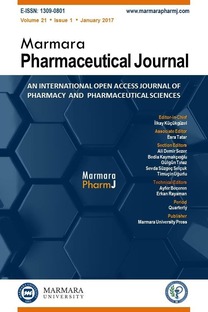Investigation of fragment based quantitative regression on a series of substituted chromen-2-one derivatives as FXa inhibitors
___
1. Bhatia MS, Ingale KB, Choudhari PB, Bhatia NM, Sawant RL. Application quantum and physico chemical molecular descriptors utilizing principal components to study mode of anticoagulant activity of pyridyl chromen-2-one derivatives. Bioorg Med Chem 2009; 17: 1654-62.2. Bohm M, Sturzebecher J, Klebe GJ. Three-Dimensional quantitative structure−activity relationship analyses using comparative molecular field analysis and comparative molecular similarity indices analysis to elucidate selectivity differences of inhibitors binding to trypsin, thrombin, and factor Xa. Med Chem 1999; 42: 458-77.
3. Hirsh J, Anand SS, Halperin JL, Fuster V. Guide to anticoagulant therapy: Heparin. Circulation 2001; 103: 2994-3018.
4. Hogg PJ, Jackson CM. Fibrin monomer protects thrombin from inactivation by heparin-antithrombin III: Implications for heparin efficacy. P Natl Acad Sci USA 1989; 86: 3619-23.
5. Weitz JI, Hudoba M, Massel D, Maraganore J, Hirsh J. Clotbound thrombin is protected from inhibition by heparinantithrombin III but is susceptible to inactivation by antithrombin III-independent inhibitors. J Clin Invest 1990; 86: 385-91.
6. Walenga JM. An overview of the direct thrombin inhibitor argatroban. Pathophysiol Haemost Thromb 2002; 32: 9-14.
7. Riva N, Lip GY. A new era for anticoagulation in atrial fibrillation. Which anticoagulant should we choose for long term prevention of thromboembolic complications in patients with atrial fibrillation? Pol Arch Med Wewn 2012; 122: 45–53.
8. Hart RG, Pearce LA, Aquilar MI. Meta-analysis: Antithrombotic therapy to prevent stroke in patients who have nonvalvular atrial fibrillation. Ann Intern Med 2007;146: 857–67.
9. Perez A, Eraso L, Merli G. Implications of new anticoagulants in primary practice. Int J Clin Pract 2013; 67: 139–56.
10. Vílchez JA, Gallego P, Lip GY. Safety of new oral anticoagulant drugs: A perspective. Ther Adv Drug Saf 2014, 5: 8-20.
11. Stewart S, Hart CL, Hole DJ, McMurray JJ. Population prevalence, incidence, and predictors of atrial fibrillation in the Renfrew/Paisley study. Heart 2001; 86: 516–21.
12. Colilla S, Crow A, Petkun W, Singer DE, Simon T, Liu X. Estimates of current and future incidence and prevalence of Atrial Fibrillation in the U.S. adult population. Am J Cardiol 2013; 112: 1142–7.
13. Hagens VE, Ranchor AV, Van Sonderen E, Bosker HA, Kamp O, Tijssen JG, Kingma JH, Crijns HJ, Van Gelder IC,RACE Study Group. Effect of rate or rhythm control on quality of life in persistent atrial fibrillation. J Am Coll Cardiol 2004; 43: 241–7.
14. Heeringa J, van der Kuip DA, Hofman A, Kors JA, van Herpen G, Stricker BH, Stijnen T, Lip GY, Witteman JC. Prevalence, incidence and lifetime risk of atrial fibrillation: the Rotterdam study. Eur Heart J 2006; 27: 949–53.
15. Hadjipavlou LD. Review, reevaluation, and new results in quantitative structure-activity studies of anticonvulsants. Med Res Rev 1998; 18: 91-119.
16. Singh Bhadoriya K, Sharma MC, Sharma S, Jain SV, Avchar MA. An approach to design potent anti-Alzheimer’s agents by 3D-QSAR studies on fused 5,6-bicyclic heterocycles as γ-secretase modulators using kNN–MFA methodology. Arab J Chem 2014; 7:924-35.
17. Patel HM, Noolvi MN, Sharma P, Jaiswal V, Bansal S, Lohan S, Kumar SS, Abbot V, Dhiman S, Bhardwaj V. Quantitative structure–activity relationship (QSAR) studies as strategic approach in drug discovery. Med Chem Res 2014;12: 4991– 5007.
18. Ajmani S, Jadhav K, Kulkarni SA. Group-Based QSAR (G-QSAR): Mitigating interpretation challenges in QSAR. QSAR & Comb Sci 2009; 28:36-51.
19. Ajmani S, Kulkarni SA. Application of GQSAR for scaffold hopping and lead optimization in multitarget inhibitors. Mol Inform 2012;31:473-90.
20. VlifeMDS: Molecular Design Suite 4.4. In., 3.0 edn: Vlife Sciences Technologies Pvt. Ltd., Pune, India. 2015.
21. Choudhari P, Kumbhar S, Phalle S, Choudhari S, Desai S, Khare S, Jadhav S. Application of group-based QSAR on 2-thioxo-4 thiazolidinone for development of potent antidiabetic compounds. J Mol Struct 2017; 1128: 355-60.
22. Halgren TA. Molecular geometries and vibrational frequencies for MMFF94. J Comput Chem 1996; 17: 553–86.
23. Baumann K. An alignment-independent versatile structure descriptor for QSAR and QSPR based on the distribution of molecular features. J Chem Inf Comput Sci 2002; 42: 26–35.
24. Veerasamy R, Rajak H, Jain A, Sivadasan S, Varghese CP, Agrawal RK. Validation of QSAR models-strategies and importance. Int J Drug Des Disc 2011; 2: 511-9.
25. Cramer RD, Patterson DE, Bunce JD. Comparative molecular field analysis (CoMFA) 1: Effect of shape on binding of steroids to carrier proteins. J Am Chem Soc 1988; 110: 5959–67.
26. Ajmani S, Agrawal A, Kulkarni SA. A comprehensive structure–activity analysis of protein kinase B-alpha (Akt1) inhibitors. J Mol Graph Model 2010; 28: 683-94.
- ISSN: 1309-0801
- Yayın Aralığı: Yılda 6 Sayı
- Başlangıç: 1985
- Yayıncı: Marmara Üniversitesi
Assessment of Cellular Responses in Kidney Cells Exposed to Cobalt Oxide Nanoparticles
Rishabha MALVİYA, Pramod Kumar SHARMA, Susheel Kumar DUBEY
Mean Centering Method for determination of Empagliflozin and Metformin
Bassam M. AYOUB, Rola M EMAM, Mahmoud M. YOUSSEF, Muhammad N. EL-KATTAN, Marwa A. SAYED, Ahmed M. KOWİDER, Adly H. SEHA, Engy A. RABEA, Rana M. YAKOUT, Rolly H. FARİED
Diş Hekimliğinde Akılcı Farmakoterapi Düzenleme Süreci
Gholamreza ASGHARI, Mohamad AKBARI, Majid ASADI-SAMANI
Fikret V. IZZETTİN, Anmar AL-TAİE, MESUT SANCAR, Mehmet ALİUSTAOĞLU
Turan ARABACI, Gizem UZAY, Ünzile KELEŞTEMUR, Merve Gökşin KARAASLAN, Sevgi BALCIOĞLU, Burhan ATEŞ
Jabbar ABBAS, Sajid BASHİR, Muhammad SAMİE, Sadaf LAGHARİ, Nargis AMAN, Habib Ullah JAN, Imran NAZIR
